The Axon 30 with Under Display Camera: Hands-on Mini-Review
by Andrei Frumusanu on September 3, 2021 9:00 AM EST- Posted in
- Mobile
- Smartphones
- ZTE
- Axon 30
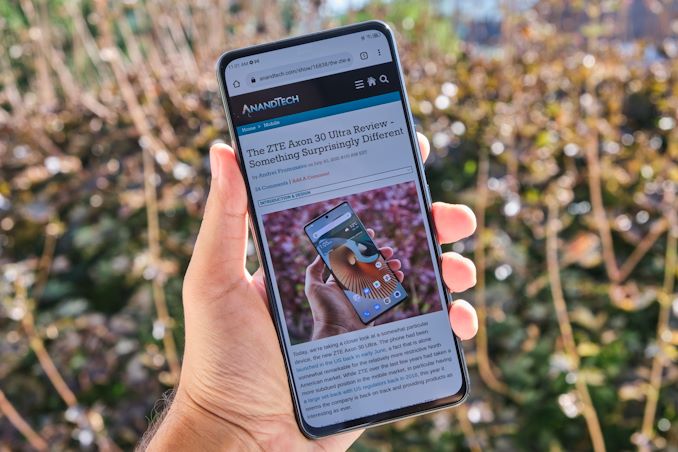
A few weeks ago, ZTE had announced a new device in their flagship line-up, the new Axon 30. The phone is an interesting device for a few reasons: it’s one of the more rare devices this year that opted to use the Snapdragon 870 rather than the newer Snapdragon 888 chip, also pricing itself much more aggressively versus the higher-end Axon 30 Ultra which we reviewed also around a month ago.
What also makes the Axon 30 interesting is the fact that this is now the second-generation under-display camera implementation from ZTE. Although we never had the chance to experience the first-gen Axon 20, we’re now starting to see more vendors attempt to implement the new technology in their new devices, and the Axon 30 is a good opportunity to have a literal closer look at how these under-display cameras work.
| ZTE Axon 30 Series | |||||
| Axon 30 Ultra | Axon 30 | ||||
| SoC | Snapdragon 888 1x Cortex-X1 @ 2.84GHz 3x Cortex-A78 @ 2.42GHz 4x Cortex-A55 @ 1.80GHz Adreno 660 @ 840MHz |
Snapdragon 870 1x Cortex A77 @ 3.2GHz 3x Cortex A77 @ 2.42GHz 4x Cortex A55 @ 1.80GHz Adreno 650 @ ?MHz |
|||
| DRAM | 8/12 GB LPDDR5 | ||||
| Storage | 128/256GB UFS 3.1 | ||||
| Display | 6.67" AMOLED 2400 x 1080 (20:9) 144Hz 300Hz Touch |
6.92" AMOLED 2460 x 1080 (20.5:9) 120Hz 360Hz Touch |
|||
| Size | Height | 161.53 mm | 170.2 mm | ||
| Width | 72.96 mm | 77.8 mm | |||
| Depth | 8.0 mm | 7.8 mm | |||
| Weight | 188 grams | 189 grams | |||
| Battery Capacity | 4600mAh 65W charging (PD3.0) |
4200mAh 65W charging (PD3.0) |
|||
| Wireless Charging | - | - | |||
| Rear Cameras | |||||
| Wide | 64MP IMX686 0.8µm pixels (1.6µm 4:1 16MP) f/1.6 w/OIS 26mm eq. |
64MP IMX686 0.8µm pixels (1.6µm 4:1 16MP) f/1.8 w/OIS 26mm eq. |
|||
| Main | 64MP GW3 0.7µm pixels (1.4µm 4:1 16MP) f/1.9 35mm eq. |
- | |||
| Ultra-wide | 64MP GW3 0.7µm pixels (1.4µm 4:1 16MP) f/2.2 13mm eq. |
8MP f/2.2 13mm eq. |
|||
| Telephoto | 8MP f/3.4 w/OIS (Periscope design) 120mm eq. |
- | |||
| Extra | 5MP Macro 2MP DoF |
||||
| Front Camera | 16MP f/2.5 |
16MP (4MP 2.24µm) f/2.45 |
|||
| I/O | USB-C 3.1 | USB-C 3.0 | |||
| Wireless (local) | 802.11ax WiFi-6E Bluetooth 5.2 LE + NFC |
802.11ax WiFi 6 Bluetooth 5.1 LE + NFC |
|||
| Other Features | Dual Speakers Under-screen optical fingerprint sensor |
Under-screen optical fingerprint sensor | |||
| Dual-SIM | Dual nanoSIM | Dual nanoSIM | |||
| Launch Price | 8+128GB: $749 / £649 / €749 12+256GB: $849 / £739 / €849 |
8+128GB: $499 / €499 12+256GB: $599 / €599 |
|||
The Axon 30 as aforementioned is one of the rare devices this year released with the Snapdragon 870 SoC. As a reminder, the 870 is a higher binned variant of the Snapdragon 865 and 865+, this time increasing the CPU frequency on the fastest Cortex-A77 core to up to 3.2GHz – quite considerably faster than the 2.84GHz of the X1 cores of the Snapdragon 888, and still faster clocked than the 3GHz Snapdragon 888+. Due to the power efficiency regressions or non-progress of the Snapdragon 888’s manufacturing node, the Snapdragon 870 should still be a perfectly viable and competent SoC in a flagship device in 2021.
The device comes in either 8+128 or 12+256GB options, similar to the Axon 30 Ultra. Other device internals of the phone are a bit more conservative versus the Ultra variant, such as the lack of WiFi 6E, only USB 3.0 connectivity, and some notable features lacking such as only a single bottom-firing speaker.
The display is a very large 6.92” AMOLED at 2460 x 1080 resolution. It still features high refresh rate up to 120Hz, but even now increases the touch sampling rate to 360Hz to reduce latency and increase responsiveness.
The phone is extremely large; at 77.8mm width it’s considerably wider than even most “large” devices out there, and definitely dwarfs the Axon 30 Ultra. Because of the quite thin side frame design and curved back glass, as well as the quite thin 7.8mm body, the phone does still manage to have good handling and does feel smaller than what it really is.
The rear of the phone is defined by the camera setup: It’s mostly just a dual-camera device for all practical purposes. The main sensor is the same as on the Axon 30 Ultra, the IMX686 at 64MP resolution which bins down to 16MP 1.6µm in regular shots. The difference here is that the Axon 30 has a smaller f/1.8 aperture optics compared to the Axon 30 Ultra.
Alongside the main camera there’s also a small 8MP ultra-wide unit with f/2.2 optics. There’s also a 5MP macro and a 2MP DoF camera – but these are generally irrelevant for photography in most use-cases. In general, the Axon 30 evidently puts a much lower focus on the camera system than the Axon 30 Ultra.
The phone has one further pratical drawback compared to the Axon 30 Ultra and that is that it’s only featuring a single bottom firing speaker. The Axon 30 Ultra was able to use the earpiece speaker as a stereo unit, and although quality there wasn’t great at least it’s better than just a mono-speaker setup like on the Axon 30.
Naturally, the most interesting aspect of the phone is the fact that it’s one of the very rare devices today with an under-screen camera. While this isn’t ZTE’s first foray into the technology, it’s definitely a much more mature and interesting implementation we’ll be taking a closer look at.
The Axon 30 comes at much cheaper pricing than the Axon 30 Ultra, starting at only $/€499 – which very much puts it well below the usual flagship device price point, so we should adjust our expectations accordingly.


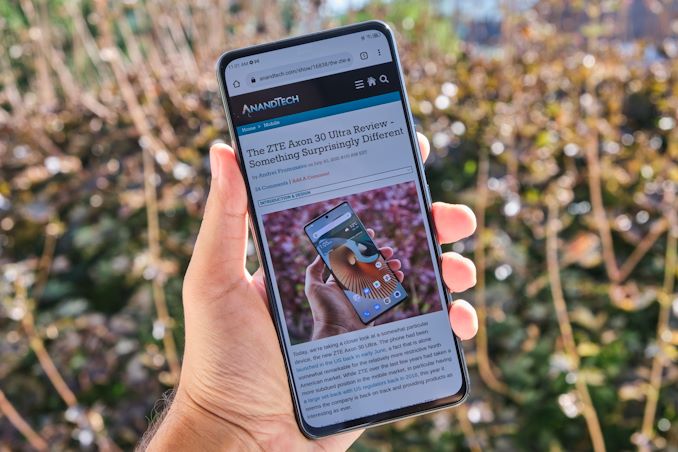
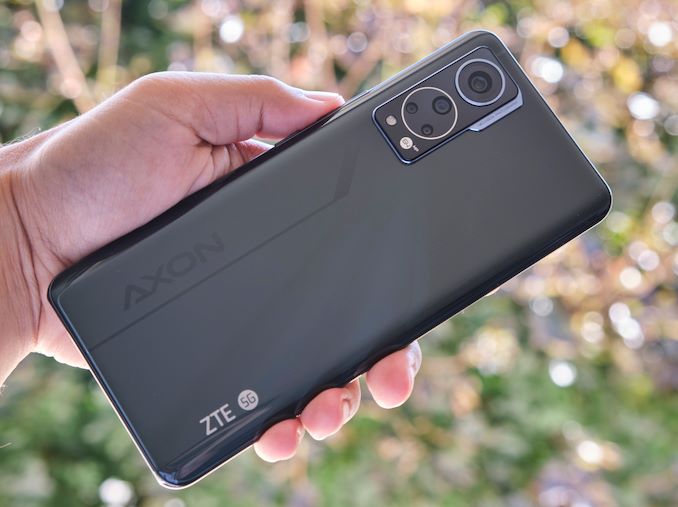
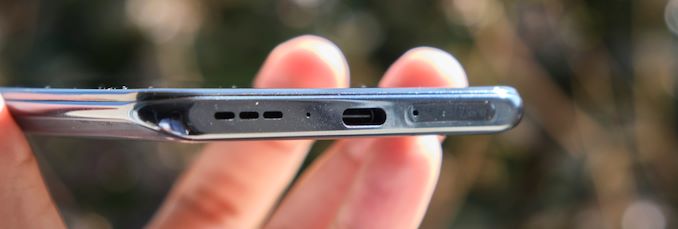
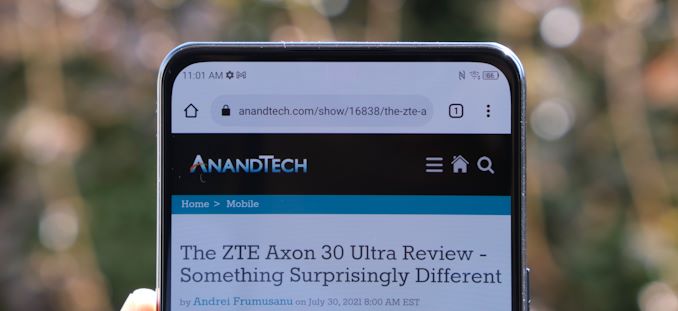








24 Comments
View All Comments
Spunjji - Monday, September 6, 2021 - link
I honestly think the compromise in picture quality from the UDC substantially outweighs the tiny functional - and questionable aesthetic - benefits of it being there in the first place. But then I'm one of those weirdos who things having a border at the top and bottom of the screen for speakers and a camera is an asset, not a flaw, and I've been outvoted by the masses. All hail the impending victory of our crappy unsharp-mask-reliant overlords! 😅Kangal - Tuesday, September 7, 2021 - link
Even funnier, you have the opposite thing when you look at the ASUS Zenfone 6/7 Pro/8 Flip.Here, you get to have the sharpest Selfie cam, and a bit of a bulge. But I like it.
I prefer the middle-ground set by the modern Sony 5.2, or the ASUS RoG 5. Other honourable mentions are the Pixel 2XL, ZTE Axon 7, Alcatel Idol 4s, Moto X Style.
Rant:
-I hate these notches and cut-outs. It's functionally bad, and an eyesore.
-And even worse are the curved screens. Why would I want to get content cut out weirdly, have the light glare back on my eyes, increase my accidental taps, and make the device fragile? Form and function should go hand in hand.
-Not to mention the weird 19:9 aspect ratio. They should stick to 16:9 for best compact, or even 17:9 is alright... anything else is just wasteful. At least Sony's 21:9 serves a purpose: very niche people who watch Ultrawide content like Hollywood Movies (not youtube) on their phone.
Tams80 - Tuesday, September 7, 2021 - link
I don't think we've been outvoted by the masses for support of bezels, but rather that most don't care if they are or aren't there (unless they are big) and just follow whatever is trendy.I'd settle for an under-display camera in the middle of the display. I'd still like at least one decent one in a bezel too though.
But hey, this AnandTech. Remember the spats over user-replaceable batteries and SD cards?
nandnandnand - Monday, September 6, 2021 - link
The phone on the phone should have been showing a phone showing a phone showing a phone...